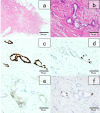Follicular lymphoma without lymphadenopathy incidentally diagnosed by sentinel lymph node biopsy during breast cancer surgery: a case report
- PMID: 36098873
- PMCID: PMC9470794
- DOI: 10.1186/s40792-022-01524-4
Follicular lymphoma without lymphadenopathy incidentally diagnosed by sentinel lymph node biopsy during breast cancer surgery: a case report
Abstract
Background: Concurrent breast cancer and malignant lymphoma is a rare phenomenon. This report describes malignant lymphoma that was incidentally diagnosed from a sentinel lymph node biopsy (SLNB) during breast cancer surgery.
Case presentation: A 73-year-old woman with a history of ovarian cancer and diabetes presented with right focal asymmetric density on a mammogram acquired during routine breast cancer screening. Ultrasonography (US) and magnetic resonance imaging (MRI) showed a 13.5-mm tumor in the upper lateral region of the right breast. A US-guided Mammotome biopsy revealed invasive ductal carcinoma of the right breast. Preoperative assessments including positron emission tomography-computerized tomography, found no evidence of axillary lymphadenopathy or distant metastasis. Because the breast cancer was stage I, the patient underwent a right mastectomy and a sentinel lymph node biopsy (SLNB) at our hospital. Pathological assessment of the biopsy revealed follicular lymphoma (FL), but no metastatic breast cancer. The patient was referred to hematology to stage the FL. Bone marrow findings were negative and stage I FL was diagnosed. After the mastectomy, she was monitored and given adjuvant therapy with an aromatase inhibitor.
Conclusions: Follicular lymphoma was incidentally diagnosed from an SLNB obtained to determine the dissemination of early-stage breast cancer. Collaboration with hematologists is important to determine optimal treatment plans for such patients regardless of the rarity of such events.
Keywords: Breast cancer; Follicular lymphoma; Malignancy; Sentinel lymph node biopsy.
© 2022. The Author(s).
Conflict of interest statement
The authors declare no competing interests.
Figures






References
-
- Lewis WD, Lilly S, Jones KL. Lymphoma: diagnosis and treatment. Am Fam Physician. 2020;101(1):34–41. - PubMed
LinkOut - more resources
Full Text Sources

